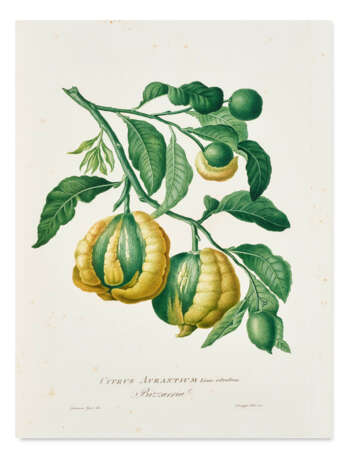ID 1129668
Lot 50 | Raccolta di fiori, frutti e agrumi
Estimate value
$ 12 000 – 18 000
Extremely rare first edition of this beautiful botanical book: the only complete copy in the auction records of RBH. This imposing color plate book is devoted to flowers, and particularly the citrus fruits that were popular in Tuscan gardens at the time. It was intended to be a complement and supplement to Giorgio Gallesio’s Pomona Italiana (Pisa, 1817–1839). It was begun by the author’s father, Ottavio Targioni Tozzetti, a Florentine botanist, physician, and friend of Gallesio. Ottavio collaborated with Gallesio and consulted him frequently about suitable artists and engravers. About 1820 Antonio began assisting his father’s work at the Giardino dei Semplici. He then initiated this publication in a series of fascicles with 3 plates and accompanying text in each, competing the work with the fourteenth fascicle. Stafleu and Cowan 13.736; Dunthorne 298; Great Flower Books p. 77 (this copy); not in de Belder nor Oak Spring Garden Library. See Daniele Vergari, “Alle Origini della Pomono Italiana,” in Rivista di storia dell'agricoltura 43 (2), 23-60 (2003).
Folio (480 x 322mm). With 42 aquatint and stipple-engraved plates, printed in colors and finished by hand, after G. Angiolini, G. Geri, P. Morini, and P. Tofani, and engraved by G. Pera and others (some spotting, repaired marginal tear to pl.1, two closed marginal tears to pl. 8, pl. 18 with oxidization stain in lower blank area). Uncut in contemporary calf-backed marbled boards, spine gilt (boards worn at edged). Provenance: Henry Rogers Broughton, Lord Fairhaven, 1900–1973 (bookplate; Sotheby’s 18 May 2022, lot 229).
| Address of auction |
CHRISTIE'S 20 Rockefeller Plaza 10020 New York USA | ||||||||||||||
|---|---|---|---|---|---|---|---|---|---|---|---|---|---|---|---|
| Preview |
| ||||||||||||||
| Phone | +1 212 636 2000 | ||||||||||||||
| Fax | +1 212 636 4930 | ||||||||||||||
| Conditions of purchase | Conditions of purchase | ||||||||||||||
| Shipping |
Postal service Courier service pickup by yourself | ||||||||||||||
| Payment methods |
Wire Transfer | ||||||||||||||
| Business hours | Business hours
|





